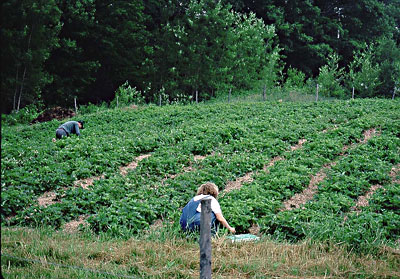 |
| Strawberry runners transplanted in August. Roberta Bailey photo |
 |
| A thick patch of strawberry plants at the end of the second summer, ready to be tilled under as weeds are encroaching. Roberta Bailey photo |
By Roberta Bailey
We all want to grow strawberries. Who can resist the allure of a basket brimming with fat, red, juicy berries? Some of us have tried, but the weeds got the better of the patch, or the chipmunks or cedar waxwings got most of the berries. And some of us have decided that growing strawberries was too much work, that it is easier to go and pick them on a farm. I did that for many years, but the idea of picking berries for my breakfast every day in late June and most of July kept tapping me on the shoulder, giving me a nudge.
That brimming basket of berries must have on my mind one August afternoon. The garlic had just been harvested, leaving an empty but well mulched plot with a high level of organic compost and residual fertility. I had already planted a few rows of Asian greens in one section and was pondering what to plant in the rest of the plot. On my way to the barn to get cover crop seed, I walked past the last surviving strawberry plants from a former patch. They were sending out runners. The runners had roots. I stopped, turned, snipped off about 30 runners and planted them about 1 foot apart in the mulch in the former garlic plot.
The plants thrived despite the heat. The following spring I gave them a light feeding of Fertrell 3-2-2 and fish meal and azomite. I weeded lightly and re-mulched them with shredded leaves. The plants grew and bloomed profusely. I did not pick off any blossoms. By late June I had huge bowls of berries every day.
Strawberries planted in late summer establish themselves well in fall. Weeds are not as vigorous in fall. Early the following spring the plants get an early start on growth and produce a very good crop of large berries. To find runners the first summer, you will have to find someone with a patch of berries; or I suppose you could purchase plants in spring with the goal of shifting the planting cycles.
By late summer, this new patch of strawberries will begin to send out runners. I let my patch develop into a thick mat of berry plants. I also took some runners and established a second patch. This time my garlic patch was too weedy, so I tilled in a small patch of Crimson clover that I had been growing on a fallow section of the garden. I added a light application of soybean meal, fish meal, azomite and Fertrell 3-2-2. (My soil tests indicate that all I need to add is a bit of nitrogen. Amend your soil according to its needs.) I covered the patch with a thick mulch of shredded leaves. Any mulch that you have available will work, but it needs to be free of weed seed.
The next spring I weeded both patches, touched up the mulch, and again added a light feeding of nitrogen and trace minerals. The 2-year-old patch was very thick with very few weeds. I had worried that this patch would be too thick, that I should have thinned it, and that the berries may rot with so little air circulation around them, or that they would be too small. Both patches yielded extremely well. The 2-year-old patch had larger berries than the new one with plenty of spacing.
By the third August, I harvested some runners from both patches to start a new patch elsewhere. I tilled in the older of the two patches, which was getting weedy and overcrowded, and I planted oats and peas on it for fall coverage.
Now every year I plant a few rows of strawberries in August or even September and then I till in the oldest patch. Each patch lives for two summer harvests. There is none of the maintenance of picking blossoms or weeding a patch for an entire year before getting any berries. Just mulch, plant, enjoy that big bowl of berries with your breakfast and fill the freezer.
